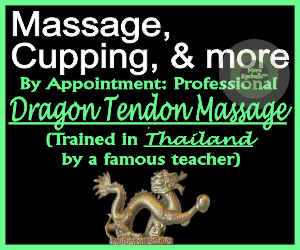
By Mitsie Vargas Ledger correspondent
In this column, we are continuing the discussion on alternative pain control modalities and treatments. Previously we discussed devices that provide pulsed electromagnetic field therapy (PEMF), transcutaneous electrical nerve stimulation (TENS) units, and cold laser. Now we will add the modalities of acupuncture, massage therapy and spinal manipulation.
In my book, ''Alt-Vet: the revolutionary pet care and longevity solution,'' I explain there are three main scientifically proven ways that can explain the physiological effects of acupuncture. First, these acupoints have been found to be conductors of electromagnetic signals. When the acupoint is stimulated with a needle, the signals increase along the pathway and they stimulate the central nervous system (CNS) to release the flow of pain-killing endorphins and immune system cells that aid in healing. These electromagnetic signals can be measured and thus points could be found using modern devices that detect those signals.
The second method of action is by activating the opioid system, which tells the brain to release chemicals that ease pain into the CNS.
Third, the acupuncture stimulation directly alters the brain chemistry by releasing neurotransmitters and neurohormones that control the body’s blood pressure, blood flow, body temperature and promote sensations of well being.
Acupuncture can be used in most dogs and cats with no ill effects. It can be delivered in multiple ways: needles, electric stimulation, pressure or injecting aqueous substances. The importance is to select the right acupoints that would stimulate the affected areas and send all the chemicals needed for pain control, repair and healing. There are more than 20,000 published articles on acupuncture and its efficacy and the evidence continues to accumulate in veterinary medicine related cases.
Massage therapy is an accepted adjunctive treatment for post-surgical and chronic pain cases in humans. In dogs and cats, there are multiple techniques but they are all striving to bring blood supply to the affected muscles. Massage therapy is not petting. There is a therapeutic intent, thus knowing pet anatomy is necessary. Pain causes the surrounding tissues and muscles to contract. This contraction, in turn, causes cramps and more pain, which becomes a repetitive cycle. So, an important part of pain control should involve manipulation of those tissues (muscles, tendons, and ligaments) surrounding the affected joints. Certified Canine Massage therapists provide care for post-surgical pain and rehab cases resulting in a faster return to function and speedy healing. Veterinarians trained in Tui Na offer deep medical massages that are similar, yet less aggressive, than veterinary "chiropractors."
Spinal manipulation is similar to human chiropractic care. The aim is to align the skeleton and muscles in the anatomically correct position that in turn will alleviate pain. Similar to chiropractic modalities it has in common that they all reduce the vertebral subluxation complex by providing motion or force to the fixated or subluxated, joint. Basically, veterinarians can palpate the spine and joints and determine whether the misalignment is causing nerves to be pinched and cause pain. There is extensive training and experience needed to be an effective pet spine manipulator and there is credentialed process and organization overseeing these specialists.
Regardless of the modality or device you choose to try for your pet, these are all effective and valid treatments that can be used to manage pain alone or in conjunction with pharmaceuticals and/or surgery.
Dr. Mitsie Vargas is at Orchid Springs Animal Hospital in Winter Haven. She can be reached at drv@osahvets.
Let's block ads! (Why?)




































































































